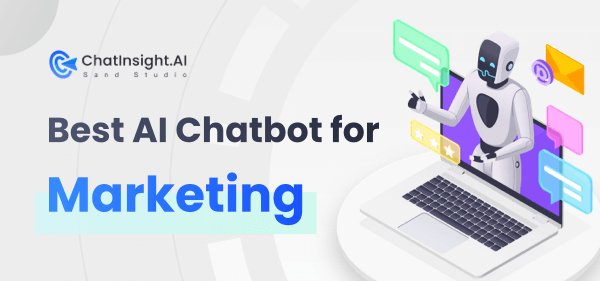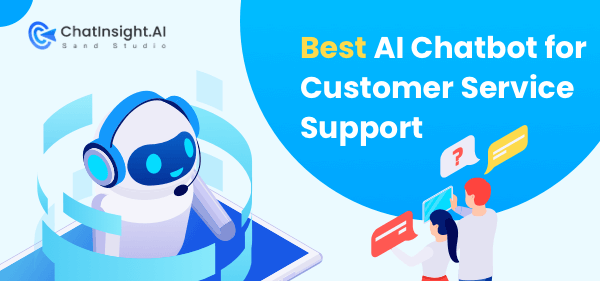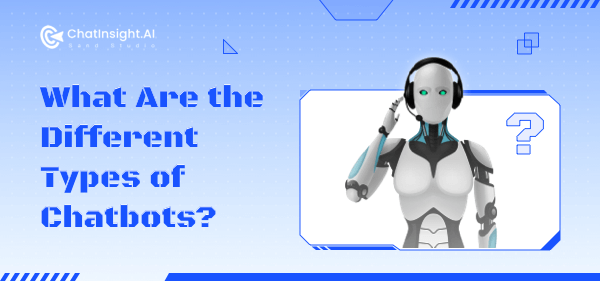A Comprehensive Guide to Build a Rule-Based Chatbot
In the digital communication landscape, chatbots are essential for improving the user experience and streamlining conversations. Rule-based chatbots are prominent among the different kinds of chatbots because of their ease of use and efficacy.
This blog is your all-inclusive guide if you're interested in building a chatbot customized to particular activities without diving into intricate machine-learning methods. We will break down the principles of creating a rule-based chatbot in the following parts.
- Part 1: What is a Rule-Based Chatbot?
- Part 2: How Does a Rule-based Chatbot Work?
- Part 3: What is the Difference between AI Chatbots and Rule-based Chatbots?
- Part 4: How to Build a Rule-Based Chatbot?
- Part 5: How to Use Rule-Based Chatbots in Business?
- Part 6: The Limitations and Challenges of Rule-Based Chatbots
- Part 7: Create an AI-powered Chatbot with ChatInsight AI
Part 1: What is a Rule-Based Chatbot?
A specific kind of conversational agent is called a rule-based chatbot. It is made to interact with users by previously determined guidelines and requirements. These chatbots function on a deterministic system, in contrast to more advanced algorithms that make use of machine learning and natural language processing. These solutions initiate with pre-programmed reactions upon identifying specified phrases or patterns within user input.
Developers manually create and design a rule-based chatbot's rules, which specify how the bot will react to different user inputs. They are, therefore, appropriate for jobs requiring well-defined and predictable interactions. Some examples include responding to often-asked queries, providing minimal customer service, or assisting users with instructions.
Moreover, rule-based chatbots are easy to operate and reliable for some use cases. But, they don't have the flexibility and learning potential of higher-level designs. They are a popular option for companies looking to automate repetitive and regular processes in a conversational way without requiring advanced algorithms. They also do not need large training datasets since they are inexpensive to design and maintain.
Part 2: How Does a Rule-based Chatbot Work?
In order to comprehend and react to human input, a rule-based chatbot functions according to a predetermined set of rules and criteria. In contrast to models based on machine learning, these chatbots are incapable of continuously learning from data and making adjustments. Instead, their interactions are guided by a predefined set of rules created by developers.
A rule-based bot operates by utilizing a sequence of conditional statements created by developers based on expected user questions and intended bot behavior. When a user inquires about company hours, for example, the chatbot is designed to identify terms like "hours," "operation," and "schedule" and provide pertinent information.
Although rule-based chatbots are less flexible and may not be able to handle complex or unexpected inquiries, they perform best in situations when conversations have a consistent flow. Rule-based chatbots work effectively for simple, task-oriented applications like customer care or FAQs.
Part 3: What is the Difference between AI Chatbots and Rule-based Chatbots?
The following information help you know about AI and rule-based chatbots!
Natural language processing or machine learning chatbots are other names for AI chatbots. They use advanced algorithms to understand natural speech and provide responses that appear human. Over time, these bots' capacity to understand context and deliver enhanced responses increases as they learn using large datasets. They are adaptable and able to manage an array of discussions and changes in response to human input.
On the contrary, rule-based chatbots rely on decision trees and predetermined rules. These rules control the bot's answers based on specific terms or patterns found in user input. The rule-based bots may have trouble with complicated or confusing language but may quickly answer simple inquiries.
AI and rule-based chatbots differ in the following ways:
Adaptability
- AI chatbots adjust and pick up new skills via conversations.
- Chatbots that are based on rules adhere to preset guidelines without the ability to learn.
Complexity
- AI chatbots manage intricate and dynamic dialogues.
- For simpler and more organized conversations, rule-based chatbots are appropriate.
Training
- Large datasets are needed for the training of AI chatbots.
- Manual rule generation is necessary for rule-based chatbots.
Understanding Context
- AI chatbots have an excellent awareness of context.
- Context-based interactions can be difficult to manage for rule-based chatbots.
Part 4: How to Build a Rule-Based Chatbot?
The rule-based bots are superior in situations when precise, consistent replies are needed, even if they might not be as technologically advanced as bots driven by machine learning.
Developers may build chatbots that can provide valuable and interesting conversations within a predetermined scope by carefully constructing the rules and replies.
- Step 1.Describe the goal of the chatbot
- Establish the chatbot's primary purpose and the tasks it will help users with. It might be anything from offering customer assistance to responding to often-requested inquiries.
- Step 2.Determine possible inputs from users
- Recognize the many kinds of messages or inquiries that users can submit to the chatbot. It involves varying the terminology and language for every inquiry.
- Step 3.Set guidelines on how to link outputs and inputs
- Create a set of guidelines that associate user inputs with suitable answers. These guidelines may be based on certain words, phrases, or patterns found in the user's communication.
- Step 4.Create dialogue flows in design
- Create a framework for the dialogues that the chatbot will have. Establish the chatbot's handling strategy for subsequent experiences and how it will lead consumers through the conversation.
- Step 5.Design responses
- Create answers that, by the matched rules, the chatbot will provide. Answers should be clear, informative, and customized to the user's question.
- Step 6.Test and improve
- Ensure the chatbot understands user input and responds appropriately by thoroughly testing it. Based on user input and performance analysis, improve the guidelines and answers.
- Step 7.Deploy the chatbot
- After you're happy with how it performs, you can either integrate it into your current systems or deploy it on the platform of your choice for user interaction. After deployment, monitor its performance and make necessary modifications to improve its effectiveness.
Part 5: How to Use Rule-Based Chatbots in Business?
Let's have a quick look at what are the main uses of a rule-based chatbot in businesses:
Customer Support
Rule-based chatbots are good at answering frequently asked questions. They provide prompt replies and assist users with pre-established troubleshooting procedures in customer care. By offering prompt support and freeing human agents to handle more complex issues, these bots improve customer satisfaction by adhering to established guidelines and ensuring consistent and accurate information.
Provide 24/7 Assistance
Rule-based chatbots are excellent at helping enterprises 24/7. When responding to consumer inquiries, these bots adhere to preset standards, guaranteeing precise and consistent replies every day. Rule-based chatbots improve customer satisfaction, expedite operations, and encourage interaction anytime, anywhere by managing repetitive activities and providing immediate responses.
Collect Customer Data
These rule-based bots are excellent at gathering consumer information for organizations. They ensure precise and well-organized data collection by asking users for the information they need according to predetermined requirements. These chatbots simplify the data collecting process, improving customer engagement and enabling tailored interactions for better overall service. They capture anything from basic contact details to specialized preferences.
Employee Onboarding
Rule-based chatbots are helpful for employee onboarding, a crucial part of business operations. These bots automate repetitive processes like form filling, policy explanations, and IT setup to provide consistent and effective onboarding experiences. They follow established protocols, provide precise information, respond to inquiries, and ease the onboarding process for new employees.
E-commerce Product Recommendations
Rule-based chatbots effectively recommend products in e-commerce by using pre-established criteria to examine user behavior, purchase history, and preferences. By making tailored recommendations, these bots improve user experience and raise the possibility of a successful transaction. Online companies may increase sales and foster customer engagement by implementing rule-based systems that effectively assist customers in their product discovery.
Lead Generation & Qualification
Rule-based chatbots are excellent at lead generation and qualifying using preset criteria to engage potential consumers and lead them through customized discussions. These bots guarantee that resources are allocated efficiently by quickly qualifying leads based on user answers. They accelerate the process with scripted events, sending qualifying leads to sales teams for additional training.
Part 6: The Limitations and Challenges of Rule-Based Chatbots
Some drawbacks of the rule-based chatbots are mentioned below:
1Lack of Contextual Understanding
Rule-based chatbots are limited by their inability to comprehend context. These bots follow preset guidelines and cannot comprehend variations or changing dialogues. They frequently struggle to understand the larger context, making it more difficult to respond appropriately and accurately when the conversation is confusing or dynamic.
2Limited Learning and Adaptation
A lack of learning and adaptability characterizes rule-based chatbots' downfall. These bots struggle to perceive context and miss details in user interactions because they cannot adapt beyond established rules. Their potential to give tailored and dynamic answers over time is restricted by this constraint, making it difficult for them to learn from experience.
3Limited Flexibility
Rule-based chatbots are restricted to predetermined scenarios due to their precise programming, which limits their adaptability. These bots find responding to various user inputs or unexpected questions difficult. Unlike adaptive AI models, they are not dynamic enough to evolve and offer complex, context-aware interactions.
4Difficulty in Handling Variability
Addressing variability is a significant drawback for rule-based chatbots. When confronted with unexpected or complex inquiries, these systems cannot adjust to a wide range of user inputs and are prone to mistakes. Rule-based chatbots are less adaptable than machine learning models when it comes to effectively navigating and responding.
5Maintenance and Scalability
Rule-based chatbots have major maintenance and scalability issues. Updating rules is difficult and time-consuming as the system expands. Any change necessitates human corrections, which raises maintenance expenses. Scalability problems occur as rule complexity increases, making it challenging to serve a range of user queries efficiently. It limits the chatbot's capacity to adjust and respond.
Part 7: Create an AI-powered Chatbot with ChatInsight AI
ChatInsight AI, an advanced platform for building chatbots with artificial intelligence, to transform how your customers interact with you. This innovative solution offers unmatched conversational experiences by merging advanced machine learning and natural language processing algorithms.
These bots can comprehend user inquiries and respond with precision and context awareness. Businesses can easily customize the Chatbot with its user-friendly interface to meet their unique demands. Say goodbye to routine conversations and hello to a proactive, client-focused strategy. In the age of intelligent consumer interactions, use ChatInsight AI to remain ahead of the competition.
ChatInsight AI is an exceptional solution designed to help companies build an AI-powered bot. You will get the service 24/7, enabling organizations to make a human-like AI chatbot. The best part of ChatInsight AI is that it makes the complete process of building a chatbot extremely easy.
- Facility of customization and management of training knowledge to attain user needs.
- Human-like engagement for every personalized conversation.
- Effectively offers support to multiple languages without requiring configuration.
Conclusion
To summarize, developing a rule-based chatbot requires thorough planning, precise rule definition, and an understanding of user objectives. The developers can build user-friendly and efficient chatbots by putting the user experience first, iterating rules in response to feedback, and connecting with relevant APIs. Note that the chatbot must be continuously updated and monitored to adapt to the demands of its users.







Leave a Reply.